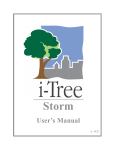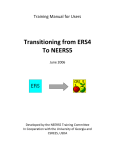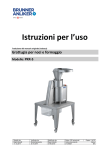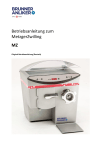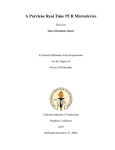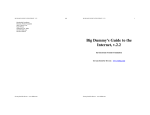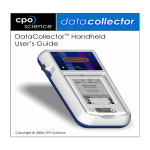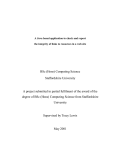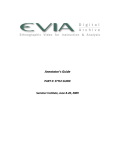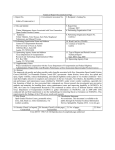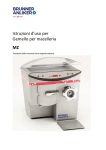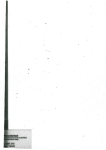Download PDF - Carolina Curriculum
Transcript
CAROLINA Tips Serving Education Since 1927 Technology-Enhanced Environmental Education BRIAN G. GRAJZAR Ecology and Environmental Science Carolina Biological Supply Company, Burlington, NC 27215 E nvironmental science rocketed into the forefront of education alongside the global expansion of science and technology. Laboratory experimentation complemented by sound field research is a key requirement of today’s environmental and ecologic coursework. The status of our surrounding environment is being measured, weighed, counted, and scrutinized as never before, and the precision of the resulting data is critical. The days of litmus paper, glassware, and stopwatchbased paper-and-pencil data recordings are numbered. Students and educators are quickly reaping the benefits of inquiry-based learning, and they are incorporating cuttingedge technology into the curriculum. In classrooms streamlined by computers and their associated accessories, the data acquisition of measurable ecologic parameters such as pH and temperature is now an easy-to-master aspect of environmental studies. The ECO-Seeker™ Environmental Data Logger combines leading-edge scientific instrumentation and easily understood protocols into a fully portable, handheld unit (Fig. 1). With probeware to sample air, water, and soil parameters, students can use the ECO-Seeker™ both in and outside traditional classroom settings. Whereas previous laboratory and field work involved painstaking manual record keeping, the ECO-Seeker™ answers the students’ frustrating question of “How do we . . .?” and affords them the opportunity to rhetorically ask “Why is this . . .?” Key Environmental Tests Any environmental study requires a thorough investigation into the abiotic (nonliving) environment. Abiotic elements include pH, temperature, turbidity, Vol. 63, No. 2 and conductivity. These promote, sustain, or limit the growth of organisms living within specific tolerance ranges. The ECO-Seeker™ provides a convenient way to measure and log abiotic parameters, then draw conclusions quickly during the limited time for field and laboratory exercises. For example, estuaries are the transition zones between fresh and salt waters along coastlines. Wide fluctuations in salinity and water levels occur in these zones because of the daily ebb and flow of the tides. Salt marsh cord grass (Spartina alterninsora), a species of water plant, is indigenous to many coastal intertidal zones. Its existence in such a dynamic habitat shows that it tolerates varying salt concentrations and water availability. Though the height of Spartina is directly proportional to its exposure to tidal level changes, it does not grow farther inland where the effect of tides are not an issue. Clearly, Harry Holloway, CPP March 2000 Visit our Web site at www.carolina.com Figure 1 The ECO-Seeker™ Environmental Data Logger. Carolina Biological Supply Company Spartina is an organism with a wide tolerance range in constantly changing environmental conditions. The conductivity of salt water is directly proportional to its salinity level. Students can leave an ECO-Seeker™ conductivity probe at the tidally influenced study site to continuously record the data points. These automatically recorded data points allow for hands-off data collection. When you are working in the field with a group of students, hands-off procedures are favorable options because time is often so limited compared to the time available in a classroom or laboratory. Having more time to observe and record the surrounding habitat is a fringe benefit provided by technologic tools such as the ECO-Seeker™. Traditional, laboratory-based experiments can also be conducted. A favorite introductory exercise for students and teachers using the ECO-Seeker™ involves a simple estuary simulation. Fill several small beakers with a water sample of varying salinity. If the beakers are randomly arranged on a lab tabletop, students can use the conductivity probe to measure and log the conductivity level of each water sample (Fig. 2). The resulting data, logged in a matter of minutes, can be played back on the LCD screen and recorded in order of increasing conductivity levels. Remembering the relationship between conductivity and salt concentration, students can rearrange the individual beakers in order of increasing conductivity/salinity levels. The resulting order simulates water samples collected in progression from the river-fed side of an estuary to the ocean-fed side. As indicated in these 2 examples, students learn to let technology work for them rather than working to learn the technology. The downtime usually associated with the monotonous act of recording data is becoming obsolete. The benefits of both laboratory and field experience provide a well-rounded environmental education for the student. High-Efficiency Learning Using the ECO-Seeker™, students can spend their class time conducting meaningful experiments while teachers Harry Holloway, CPP 2 Figure 2 Measure and log the conductivity of water samples. are afforded time to instruct and guide rather than plan lengthy preparatory sessions. Enhanced student participation fosters a more enriched and challenging academic atmosphere. The Environmental Manual included with the ECO-Seeker™ supplies a short curriculum of activities centered around quick and easy environmental experiments. One such activity allows students to become “environmental detectives” who search for simulated contamination sources in soil. The setup is easy. Teams of students each work on a simulated test field that consists of a shallow tray filled with soil. A localized area of the test field is “polluted” by the teacher. The pollutant can be anything from lemon juice to vinegar. The test field is divided into a grid, and soil samples are tested from each quadrant on the grid using the ECO-Seeker™ conductivity and pH probes. The resulting data pinpoints the contaminated location in the test field. Background information, lists of materials, and data analysis questions tailored to each experiment simplify a teacher’s classroom presentation. Detailed, easy-to-follow procedures encourage student involvement. Enterprising students can undertake and organize self-initiated student research projects. The benefit of providing a forum for students to encounter their first positive experience with technology is immeasurable. The more comfortable students are handling sophisticated classroom computers, software, and other advancements such as the ECO-Seeker™, the better prepared they are to make well-informed environmental decisions in the future. Harry Holloway, CPP Education as Prevention Figure 3 Students can use the ECO-Seeker™ outside the classroom. Students in our “green-conscious” society have grown up alongside the environmental studies and ecologic issues that are shaping our state, local, and national governmental policies. An example is soil erosion—the movement of soil from one location to another. Whether borne on the wind or washed off cultivated fields by rainstorms, soil is fast clogging our lakes, rivers, and streams. The ECO-Seeker™ can be used to perform a classic experiment illustrating the effects of soil erosion and surface water runoff. Students measure water samples from a stream or river before and immediately after a heavy rainstorm (Fig. 3). The turbidity, or level of light Carolina Biological Supply Company 3 Harry Holloway, CPP transmission through the water samples, can be logged acting as both a meter and data logger. The ECO-Seeker™ using an ECO-Seeker™ turbidity probe. The turbidity level software also generates graphs. All of this, combined with of the prestorm water samples should be relatively low, the capacity to log multiple, simultaneous, and whereas the turbidity of the independent probe readings, poststorm water samples is allows students to learn how much higher due to the ecologic systems change suspension of soil and other over time, and how one particles in the water. The piece of the puzzle affects the increase in turbidity levels entire picture. is related directly to the erosion In an age of faxes, emails, of the waterway’s surrounding and cell phones, computers in topsoil, the decaying of plant the classroom are fast becoming matter, and the leaching commonplace and crucial. In of groundwater. the past 10 years alone, the The Dust Bowl occurred computer intensity (the ratio of over the Great Plains in the students to instructional-use 1930s because of poor computers) in public schools environmental management. has been improved from as Today’s students need a sound high as 40:1 to better than 7:1. background in environmental Finding a means to link the studies to comprehend the laboratory-generated data and governmental regulations field-collected statistics with the stemming from the Dust Bowl memory and number-crunching debacle that encourage capabilities of computers is as preventative farming practices necessary for the students of such as terracing and contour today as a sturdy quill and ink planting, along with associated bottle were to students early remedial techniques. The last century. The ECO-Seeker™ environmental science Environmental Data Logger laboratory, especially when provides a means for students supplied with technologic tools to embark on their own like the ECO-Seeker™, can help technology-based journey of Figure 4 Let the ECO-Seeker™ work while you complete develop such a background. scientific discovery. other tasks. Uncompromising Versatility A smooth transition between manipulating a student’s raw data and benefiting from computer-aided graphing software involves linking the data-logging ECO-Seeker™ to a computer. By doing so, students make possible the direct downloading of experimental data or the actual real-time monitoring of live experiments. The flexibility provided by the compact and versatile ECO-Seeker™ is almost limitless. Specifically, an easy streamside experiment can be conducted in the field and the data can be analyzed indoors using the classroom computer. Investigate the air and water temperatures at a given streamside location and see how each changes with respect to one another over time. The ECO-Seeker™, equipped with 2 thermistors (temperature probes), can be used to record data overnight by taking a temperature reading every 30 minutes. One probe can be placed in the stream, and the other can be left just above the water’s surface. While students are asleep at home, the ECO-Seeker™ will be hard at work automatically recording up to 190 temperature data points (Fig. 4). When students return to school the next morning, the ECO-Seeker™ can be retrieved from the stream bank and the logged data analyzed using its computer-based graphing software. Students learn not only the heat retention differences of water and air, but also learn how to plan, set up, and run a scientific investigation using a technology-aided scientific method. The ECO-Seeker™ provides teachers and students an economical, user-friendly, and rugged device capable of Further Resources Miller, G. Tyler. 2000. Living in the Environment: Principles, Connections, and Solutions, 11th Edition. Brooks/Cole Publishing Company, New York. Mitchell, Mark and Mitchell, William. 1997. Field Manual for Water Quality Monitoring: An Environmental Education Program for Schools. Kendall-Hunt, New York. Rosenthal, Dorothy B. 1995. Environmental Science Activities. John Wiley & Sons, Inc., New York. Web Sites http://www.carolina.com http://www.globe.gov/ http://www.envirolink.org/enviroed/content.html CAROLINA Tips Carolina Biological Supply Company 2700 York Road, Burlington, NC 27215 336-584-0381 Web site: www.carolina.com Email: [email protected] ISSN 0045-5865 EDITOR Phil Owens, PhD • ADVERTISING DIRECTOR Harry Shoffner CREATIVE DIRECTOR Bruce A. Anliker PHOTOGRAPHY Harry F. Holloway, CPP & Jeff McAdams Carolina Biological Supply Company PRESORTED STANDARD US POSTAGE PAID CAROLINA BIOLOGICAL SUPPLY COMPANY 2700 York Road Burlington, NC 27215 Change Service Requested ATTENTION MAILROOM: If addressee has left, please forward to Science Teacher. TM Moving? If so, please notify our Mailing List Office of your new address. Be sure to include your old address information as it appears on the mail panel above. This way you won’t miss a single issue of Carolina Tips. Carolina™ ECO-Seeker™ Environmental Data Logger Carolina™ ECO-Seeker™ Deluxe Sampling Package Developed to provide a more in-depth search into environmental testing, this complete package will complement any hands-on student investigation by providing 4 additional probes and our exclusive Carolina™ Environmental Experiments Manual. ECO-Seeker™ Conductivity Probe pH Probe Standard Thermistor Stainless Steel Thermistor Turbidity Probe 9-V AC Wall Power Supply Carolina™ Environmental Experiments Manual Operator’s Guide CT-18-6100 Per pkg $745.00 Carolina™ ECO-Seeker™ Probeware CT-18-6116 CT-18-6118 CT-18-6120 CT-18-6122 CT-18-6124 Conductivity Probe pH Probe Standard Thermistor Stainless Steel Thermistor Turbidity Probe Each Each Each Each Each $ 40.00 $105.00 $ 32.00 $ 40.00 $105.00 Carolina™ ECO-Seeker™ Software Sets CT-18-6130 CT-18-6132 PC Set Macintosh Set Each Each $105.00 $105.00 ORDER TODAY! Phone: Fax: 800-334-5551 The simple-to-learn and easy-tooperate technology allows every student to master the ECO-Seeker™ in a minimal amount of time. Only 30 minutes of simple instruction is required before students can begin investigating their environment and surrounding habitats. Gone are the days of litmus paper, glassware, and paper-and-pencil data recordings. This multifunctional, hand-held unit can be used to monitor parameters such as pH, temperature, turbidity, and conductivity while logging them all simultaneously. Weather station parameters are also measurable. This goanywhere data collection tool automatically calibrates and recognizes each of up to 4 individual probes. Stored data can be viewed directly on the high-resolution LCD screen. Utilizing the available software, downloading and actual real-time experimentation with graphing capabilities can also be accomplished by interfacing with either your Mac or PC. No setup or programming is required. Includes the ECO-Seeker™, stainless steel thermistor, 9-V AC wall power supply, and operator’s guide. Specifications Channels: Display: 4 Analog/digital High-resolution LCD, 4 lines x 20 charaters, displays all channels 6” L x 4” W x 11⁄2” H Dimensions: By interfacing the ECO-Seeker™ with your computer, this easy-to-use software enables you to interpret data by either downloading stored data or performing real-time experiments. No programming is necessary. The graphing capabilities of the software allow for immediate and practical manipulation of student-collected data. Each set includes a software diskette, comm port adapter cable, and user’s manual. 800-222-7112 Online: www.carolina.com Phone: 800-334-5551 Fax: 800-222-7112 Email: [email protected] Weight: Resolution: Data Storage: Accuracy: Power: Sampling Rate: Operating Modes: CT-18-6108 Each 1 lb 12 bit Up to 190 simultaneous readings per channel in nonvolatile memory Within 0.1% of full-scale voltage input 2 AA batteries or 9-V AC power supply Selectable: every 1 s, 5 s, 10 s, 20 s, 1 min, 5 min, 10 min, 30 min, 1 hr Probe meter (reads 4 probes simultaneously), autorecording, manual recording, data playback, sample-and-hold $450.00 Carolina™ ECO-Seeker™ Manuals Each manual contains unique experiments highlighting the versatility of the ECO-Seeker™. CT-18-6110 CT-18-6112 Environmental Experiments Each Middle School Experiments Each Carolina Biological Supply Company 2700 York Road, Burlington, NC 27215 $19.95 $19.95




